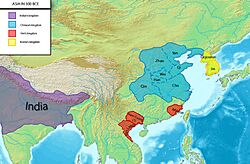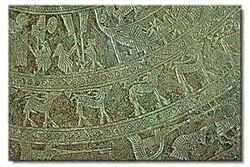Hồng Bàng dynasty facts for kids
Quick facts for kids
State of Xích Quỷ
赤鬼 (legendarily 2879–2524 BC) State of Văn Lang 文郎 (legendarily 2524–258 BC) |
|||||||
|---|---|---|---|---|---|---|---|
| Status | Kingdom | ||||||
| Capital | Ngàn Hống (2879 BC – 2524 BC) Nghĩa Lĩnh (29th c. BC) Phong Châu (2524 – 258 BC) |
||||||
| Religion | Animism, folk religion | ||||||
| Government | Monarchy | ||||||
| King | |||||||
|
• 2879–2794 BC
|
Hùng Vương I (first) | ||||||
|
• 408–258 BC
|
Hùng Vương XVIII (last) | ||||||
| Historical era | Ancient history, Bronze Age, Iron Age | ||||||
|
|||||||
| Today part of | Vietnam China |
||||||
The Hồng Bàng period (Vietnamese: thời kỳ Hồng Bàng) was a very old time in Vietnam's history. It's also known as the Hồng Bàng dynasty. This period lasted for a long time, from about 2879 BC to 258 BC. It began with Kinh Dương Vương ruling a kingdom first called Xích Quỷ, which later became Văn Lang. It ended when An Dương Vương took over.
An old Vietnamese history book from the 15th century, called Đại Việt sử ký toàn thư, says that Kinh Dương Vương was the first "Hùng king" (Vietnamese: Hùng Vương). The Hùng king was like an absolute ruler, meaning they had complete control over the land and its resources. The capital city of Văn Lang was Phong Châu, which is in modern-day Phú Thọ Province in northern Vietnam.
Contents
What Does Hồng Bàng Mean?
The name Hồng Bàng comes from old Chinese words used in early Vietnamese history books. It means "mythical giant bird."
The name Văn Lang is also very old. Some experts think it's related to words for "human being" or "person" in other Southeast Asian languages.
History of the Hồng Bàng Period
Life Before the Kings
People have lived in the area now known as Vietnam for a very long time. Some old sites show people lived there about half a million years ago. Early humans lived in caves, and later, more advanced groups appeared.
Between 5000 and 3000 BC, many tribes lived in northern Vietnam. They settled near rivers like the Hồng (Red), Cả, and Mã rivers. These tribes started to develop farming, especially growing rice using irrigation. This led to the growth of small tribal states and villages.
The Xích Quỷ Kingdom
Legend says that in 2879 BC, a leader named Lộc Tục came to power. He brought many tribes together and formed a united nation. Lộc Tục called himself Kinh Dương Vương and named his new country Xích Quỷ.
The name Xích Quỷ means "red demon." This name comes from old Chinese ideas about stars and directions. "Red" is linked to the South, and "demon" refers to a star group in the South.
Kinh Dương Vương is seen as the first leader of Vietnam and the ancestor of the Hùng kings. He is also famous for teaching his people how to grow rice.
The Văn Lang Kingdom
Around 2524 BC, the kingdom was renamed Văn Lang. The capital was moved to Phong Châu, where three rivers meet. People in Văn Lang were skilled. They even knew how to track the lunar calendar by carving marks on stones.
According to Vietnamese legends, Văn Lang once fought a war against an invasion from Shang-China. Văn Lang won this war, thanks to a brave general named Gióng.
The Hồng Bàng period ended around 258 BC. A military leader named Thục Phán conquered Văn Lang and took over from the last Hùng king.
The Âu Lạc Kingdom
After taking over Văn Lang, Thục Phán united different tribes to create a new kingdom called Âu Lạc. He became known as An Dương Vương. He built his capital and a strong fortress called Cổ Loa Citadel near modern-day Hanoi.
How Văn Lang Was Organized
The first Hùng King created the "Vietnamese" state to help people work together. This was important for building hydraulic systems (like dikes for rice fields) and for defending against enemies.
The Hùng king was the main ruler. Under him, there was a court of advisors called lạc hầu. The country was divided into fifteen "regions" called bộ. Each bộ was ruled by a lạc tướng, who was often a member of the Hùng king's family. These regions included farming villages, often led by an elder.
Princesses were called "mỵ nương," and princes were called "quan lang."
Old stories say that Văn Lang's northern border reached parts of modern Hunan in China. Its southern border went down to the Cả River delta. However, archaeologists haven't found proof for these exact borders.
Here are the regions of Văn Lang, according to an old Vietnamese history book:
| Name | Present-day location |
|---|---|
| Phong Châu (King's capital) | Phú Thọ Province |
| Châu Diên (朱鳶) | Sơn Tây Province |
| Phúc Lộc (福祿) | Sơn Tây Province |
| Tân Hưng (新興) | Hưng Hóa (part of Phú Thọ Province) and Tuyên Quang Province |
| Vũ Định (武定) | Thái Nguyên Province and Cao Bằng Province |
| Vũ Ninh (武寧) | Bắc Ninh Province |
| Lục Hải (陸 海) | Lạng Sơn Province |
| Ninh Hải (寧海) | Quảng Yên (a part of Quảng Ninh Province) |
| Dương Tuyên (陽泉) | Hải Dương Province |
| Giao Chỉ (交趾) | Hà Nội, Hưng Yên Province, Nam Định Province and Ninh Bình Province |
| Cửu Chân (九真) | Thanh Hóa Province |
| Hoài Hoan (懷驩) | Nghệ An Province |
| Việt Thường (越 裳) | Quảng Bình Province and Quảng Trị Province |
| Cửu Đức (九德) | Hà Tĩnh Province |
| Bình Văn (平文) | Ninh Binh from Day river to Mount Tara Diep |
Culture and Economy
Farming and Daily Life
The people of Văn Lang mainly grew rice paddy. They also did handicrafts, hunted, gathered food, raised animals like buffaloes, chickens, and pigs, and fished. They were very skilled at working with bronze. The famous Đông Sơn Bronze Drums show pictures of their houses, clothes, customs, and daily life.
The Hùng kings ruled with the help of the Lạc Tướng. These officials managed the villages around the rice fields. They organized the building and upkeep of dikes and controlled the water supply for farming. People also made pottery, worked with bamboo, made baskets, and wove fabrics from hemp, jute, and silk.
Around 2000 BC, people in northern Vietnam developed advanced farming. They used a complex system of canals and dikes to irrigate their rice fields. This type of farming was very important to Vietnamese society. It needed strong village communities to work together on the irrigation systems. This led to more food and allowed more people to live in the area.
Bronze Tools and Art
By about 1200 BC, people in the Mã River and Red River plains became very good at growing wet rice and casting bronze. This led to the Đông Sơn culture, famous for its detailed bronze drums. The bronze weapons, tools, and drums show that this bronze-making skill came from the local people. Many old copper mines have been found in northern Vietnam.
The Đông Sơn culture shares similarities with other Southeast Asian cultures. These include using boat-shaped coffins, living in houses on stilts, and customs like chewing betel nuts and blackening teeth.
Pottery Making
Between 3000 BC and 500 BC, people in northern and southern Vietnam made more and more advanced pottery. They started using pottery wheels, though they still used older methods too. The pottery was often smooth, polished, and sometimes red.
Archaeologists can tell different cultures apart by the patterns carved into the pottery. In the Red River Valley, there were three main cultures before Đông Sơn: Phùng Nguyên, Đồng Đậu, and Gò Mun. Their pottery styles changed, but they showed a continuous development of culture.
The Đông Sơn culture's pottery was fired at high temperatures and came in many shapes. However, the decorations were simpler than in earlier periods.
Timeline of the Hồng Bàng Period
The Hồng Bàng period is divided by the rule of each Hùng king. The exact dates are still being researched, but these are the estimated times:
|
|
|
|
|
See also
- Văn Lang University
- Việt Nam sử lược
- Đông Sơn culture




